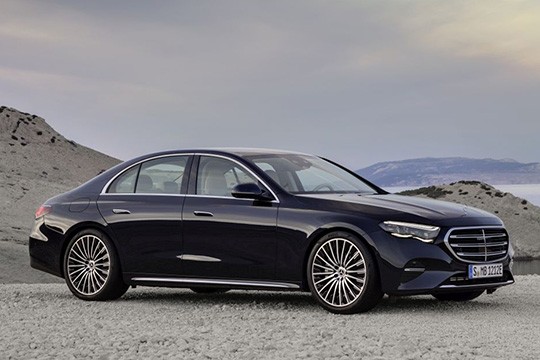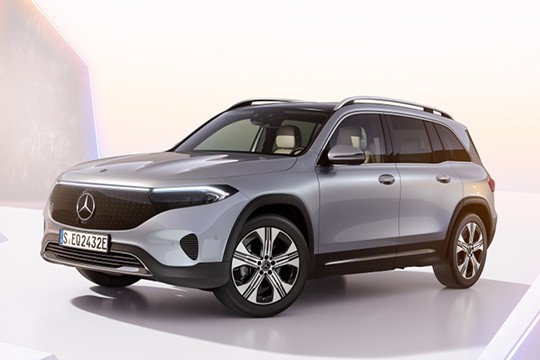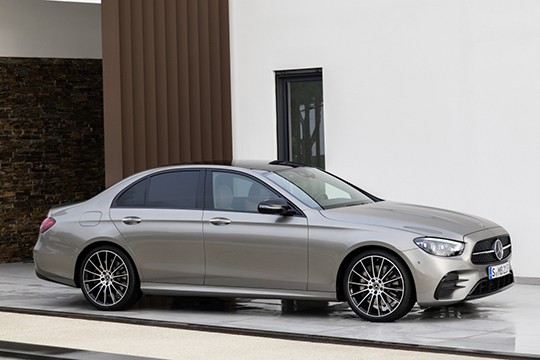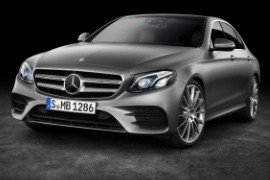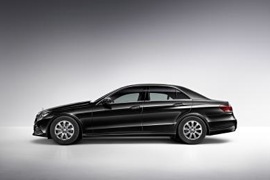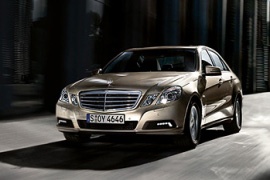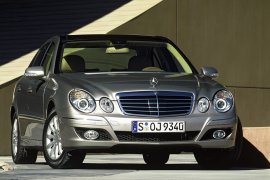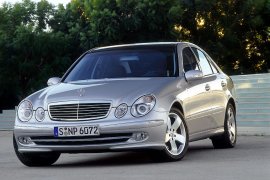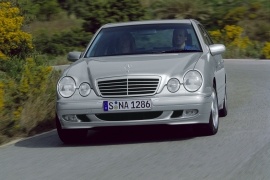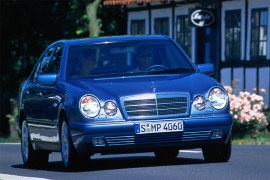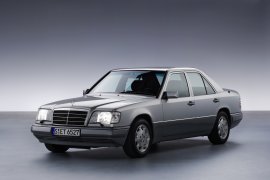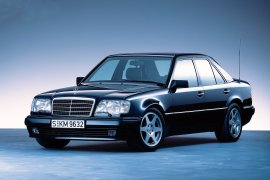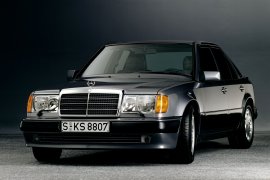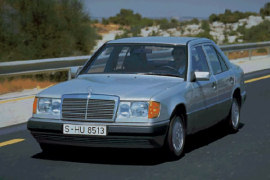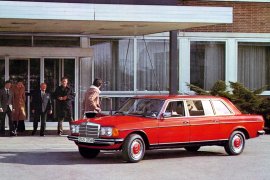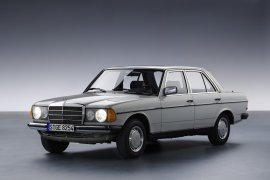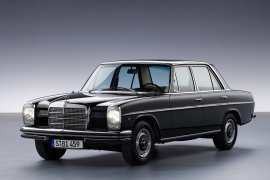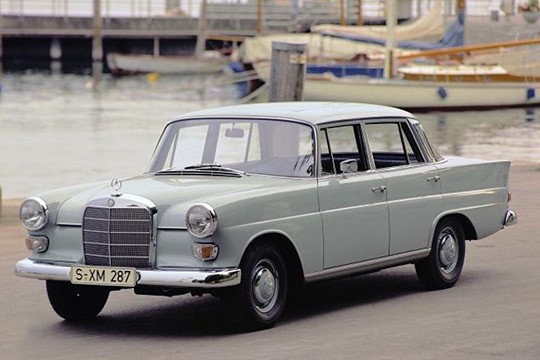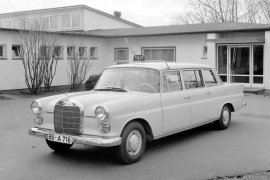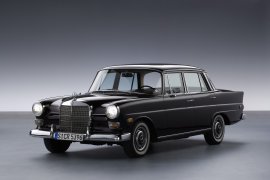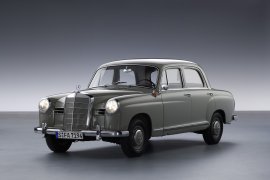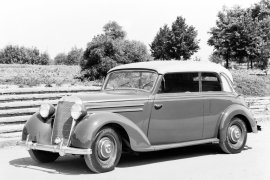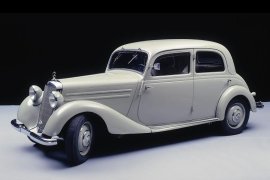MERCEDES BENZ E-Klasse and predecessors Models/Series Timeline, Specifications & Photos
First production year: 1946
Engines: Hybrid gasoline, Mild hybrid diesel, Plug-in hybrid, Mild hybrid, Diesel, Hybrid diesel, Gasoline, Natural gas, Hybrid
Mercedes-Benz introduced the sixth generation of the E-Class (W214) in the spring of 2023, replacing the W213 lineup after seven years.
Even though the change towards electromobility was riding the high tides, the German automaker launched the 2024 E-Class based on a platform suitable for internal combustion engines. Even though it provided the vehicle, among other engine options, with plug-in hybrid versions, it wasn't available as a full-electric car.
With a design inspired by its bigger sibling, the S-Class, the 2024 E-Class was available right from the start in two major trim lines: AMG and Exclusive. The main grille was adorned with three-pointed star badges for the former, while the latter sported three chromed horizontal slats. The German automaker also added a light contour for the grille, emphasizing the car's luxurious look. All versions boasted LED headlights with an option for an intelligent lighting system. From its profile, the E-Class resembled its bigger brother thanks to its long wheelbase and the cab-rearward design of the greenhouse. As a final touch, at the back, the E-class featured a new design for the taillights that consisted of three-pointed stars shaped lamps.
Inside, the automaker took inspiration from the EQE and EQS and installed a digital dashboard in front of the driver, complemented by a super-screen of 14.9” atop the center stack. In addition, the automaker added a third optional display in front of the side passenger. Mercedes-Benz also used different interior trims (carbon-fiber or wood) for the interior, depending on the selected line of equipment: AMG or Exclusive. Thanks to the longer wheelbase than on its predecessor, the W214 provided better legroom in the back, almost as good as on the S-Class.
Mercedes-Benz offered the 2024 E-Class with a range of ICE-only or plug-in hybrid versions for the entire range, with either rear or all-wheel drive systems. All versions could've been ordered with the carmaker's nine-speed automatic transmission. The automaker also offered the option for rear-wheel steering and adaptive suspension, although the last feature was unavailable for plug-in hybrid drivetrains.
Mercedes-Benz introduced the EQB on its lineup in late 2021 but didn't keep it too long in that shape since, in the summer of 2023, it already refreshed it to match the look of other EQ products made by the German automaker.
The three-pointed star brand started to divide its brand into more categories. Its regular cars sported the Mercedes-Benz name; the performance ones had the Mercedes-AMG badge, while the electron-powered ones got the Mercedes EQ nameplates. Besides the EQE, EQS, and EQS SUV, the EQB followed in line as the smallest seven-seat electric vehicle from the automaker's lineup.
One of the most striking differences between the 2022 and the 2024 model years of the EQB was the front fascia. Unlike its predecessor, this one featured a styling inspired by its larger sibling, the EQS SUV. The panel sported a new look, with either a piano-black fascia or with one adorned by tiny little stars. For both versions, the automaker installed full-LED headlamps with a continuous LED light strip that crossed the car from side to side at the upper side of the front fascia. Since electric vehicles didn't need a broad cooling area, the automaker installed just a lower grille to cool the batteries and the electrical system. From its profile, there weren't any major changes, apart from the new color options offered by Mercedes-Benz. At the back, the automaker created a new design for the rear lights featuring horizontal lines that ran across the tailgate from side to side and were extended by the corner-mounted taillights.
Inside, there were subtle changes for the vehicle. Customers could've ordered the vehicle with specific ambient lighting that also incorporated tiny little three-pointed star lights embedded on the dashboard on the passenger' side. Still, the main screen that combined the instrument panel and the MBUX infotainment system was covered by the same piece of glass, creating a wide display. Apart from the two passengers up front, the EQB offered enough room for the other five passengers, with three in the middle row and two on the flat-folding jump seats in the trunk area. Maximum trunk space with the last two rows folded was 1620 liters (57.2 cu-ft).
Under the skin, Mercedes used the electric technology to power the vehicle and offered the MQB with front- or all-wheel-drive systems. The battery pack inside the floor provided enough juice to power the car for up to 560 km (348 miles) on a single charge, depending on the version, according to WLTP standards. But one of the most interesting upgrades made to the facelifted version of the EQB was the introduction of the towing package. With this, Mercedes promised that customers could tow up to 1400 kilos (3086 lbs.) or 1700 kilos (3748 lbs.) for the FWD or the AWD versions, respectively.
The three-pointed-star German brand introduced a facelifted version of its respected executive sedan E-Class in 2020, as a measure for the Euro 6d norms, which started in January 2021.
Ever since 1953, before even the E-Class had that name, the luxurious Mercedes-Benz range was well received by the market. Each time a new generation was introduced, it was a benchmark for its class. The first generation to receive the E-Class badge was the facelifted, 1993, W124 model. The 2020 model was the facelifted version for the fifth generation, which stormed the showrooms in 2017.
Mercedes-Benz introduced the facelift in 2020 with a new set of LED headlights and flatter housings, while the multibeam led headlamps including ultra range high beam were available as an option The diamond-style, 3D design of the grille was enhanced, and the A-shaped lower grille design of the apron amplified the dynamic style. Two powerdomes on the hood evoked a V engine, even if some models received inline-four units. The new LED taillights design and the chromed splitter made the car looks sportier. The AMG line featured a different aerodynamic package.
To lower the emissions, the four-cylinder engine received an integrated starter-generator (ISG) and a 48v architecture. A recuperation function and the ability to "glide" with the engine switched off made the engine even more efficient. The electrification continued on all the gasoline engines as well and three hybrid versions were available. The only gearbox available for the entire range was the 9G-Tronic (dual-clutch) automatic.
The fifth generation of the Mercedes-Benz E-Class was unveiled in 2016 at the North American International Auto Show. It was a clear departure from the previous design language.
In the mid-'90s, Mercedes-Benz switched from a mono-bloc headlights design to a dual headlamp, which could be seen on the E-Class and it was used until 2016 with the launch of the fifth generation of the mid-size sedan of the German brand.
The front end underlined the business-class sedan status of the car. It boasted a different look for each design and equipment line. The base model featured the classic Mercedes-Benz grille with the star on the hood, as the Exclusive line. The Avantgarde and AMG Line models were identifiable by sports grille with a large badge in the middle. The broad shoulders over the rear wheel arches amplified the image of the car and, in the rear, the single-piece taillights featured a two-bar design.
Inside, the 2016 E-Class offered as an option two high-resolution displays, each with a wide diagonal of 12.3”, a first in that segment. Beneath the shared class cover, the two displays appeared as a widescreen, forming a single horizontal long display with the instrument cluster and the infotainment system. In addition, touch-sensitive control buttons ('Touch Controls') on the steering wheel made their first appearance in a car. Like a smartphone interface, they responded to horizontal and vertical swiping movements, allowing the driver to control the entire infotainment system using finger swipes without having to take their hands off the steering wheel.
The 2016 Mercedes-Benz E-Class was launched with a choice of two engines: the E 200 with a four-cylinder gasoline unit and the E 220 d with an all-new four-cylinder diesel.
Mercedes-Benz introduced a long-awaited facelift for the fourth generation of the E-Class in late 2012 for the 2013 model year.
When the W212 broke covers in 2009, during the world financial crisis, customers were in shock. After two generations fitted with round headlights, this new model came with four squared-looking ones. And they didn't look appealing at all. Yet, they created a controversy that helped the sales. But Mercedes-Benz knew that it would have to fix that issue along with the refreshed version, which occurred in 2012.
The new front fascia featured two swept-back headlights adorned with LED daytime running lights. In addition, the hood and the lower bumper were redesigned. Thus, from a boxy look, the updated E-Class W212 changed to a waved, curved styling. As a consequence, the front fenders, the doors, and the rear quarter panels were also replaced. The car also lost its enlarged wheel arches, which were not exactly suitable for a premium vehicle. Another significant update was for the taillights, which ditched the regular bulbs for LEDs.
Inside, there were other significant improvements. Thus, at the front, the reshaped dashboard featured a new infotainment screen placed atop the center stack. It was still controlled by a rotary knob and a touchpad placed between the front seats. For vehicles fitted with automatic gearboxes, the carmaker moved the gear selector from the center console to behind the steering wheel in the shape of a stalk.
Another significant upgrade was for gearboxes, which were either six-speed manuals or seven-speed automatics.
MERCEDES BENZ E-Klasse (W212) 200 6MT (184 HP)
MERCEDES BENZ E-Klasse (W212) 200 7AT (184 HP)
MERCEDES BENZ E-Klasse (W212) 250 7AT (211 HP)
MERCEDES BENZ E-Klasse (W212) 300 4Matic 7AT (252 HP)
MERCEDES BENZ E-Klasse (W212) 300 7AT (252 HP)
MERCEDES BENZ E-Klasse (W212) 350 4Matic 7AT (306 HP)
MERCEDES BENZ E-Klasse (W212) 350 7AT (306 HP)
MERCEDES BENZ E-Klasse (W212) 400 4Matic 7AT (333 HP)
MERCEDES BENZ E-Klasse (W212) 400 7AT (333 HP)
MERCEDES BENZ E-Klasse (W212) 200 CDI 6MT (136 HP)
MERCEDES BENZ E-Klasse (W212) 200 CDI 7AT (136 HP)
MERCEDES BENZ E-Klasse (W212) 220 BlueTEC BlueEFFICIENCY 7AT (170 HP)
MERCEDES BENZ E-Klasse (W212) 220 CDI 6MT (170 HP)
MERCEDES BENZ E-Klasse (W212) 220 CDI 7AT (170 HP)
MERCEDES BENZ E-Klasse (W212) 220 CDI Eco 6MT (170 HP)
MERCEDES BENZ E-Klasse (W212) 250 CDI 4Matic 7AT (204 HP)
MERCEDES BENZ E-Klasse (W212) 250 CDI 6MT (204 HP)
MERCEDES BENZ E-Klasse (W212) 250 CDI 7AT (204 HP)
MERCEDES BENZ E-Klasse (W212) 300 BlueTec 7AT (231 HP)
MERCEDES BENZ E-Klasse (W212) 350 BlueTEC 4Matic 7AT (252 HP)
MERCEDES BENZ E-Klasse (W212) 300 BlueTec Hybrid 7AT (231 HP)
Mercedes-Benz introduced a new generation of the E-Class in 2009 when the world financial crisis was about to end, and automakers started to see the first rise in their sales numbers.
Whether the German automaker waited or not to see the end of the crisis is debatable. We know that its predecessor, the W211, was built for more than seven years, and this one lasted less than that. It was available in three trim levels and received a facelift four years after its introduction.
The styling was shocking for most of its customers. After two generations of double-round headlights, this model came with double square-ish ones. Moreover, the inner ones featured sharp lines, and the outer ones sported a completely different styling. If the front fascia was not the best part of the vehicle, the sides with their bulging rear quarter panels offered a more muscular look. Just remember, though, that this was not a sports sedan.
The interior featured a dashboard with a double instrument cluster, which was extended above the center stack and hosted the infotainment unit's display. Even though many automakers had already adopted touchscreens, the Mercedes-Benz relied on a swiveling dial placed on the center console, between the seats, to access the menus. It was the carmaker's choice. The same idea was used by its main rival, BMW. The E-Class offered a lot of room inside the cabin, with a pair of bucket seats at the front and a bench profiled for two in the back. Yet, it was easy to fit three adults in the back.
Under the hood, the W212 received a choice of diesel and gasoline engines that were paired with either a five- or a seven-speed automatic gearbox. While most versions featured a rear-wheel drive system, the carmaker also offered the 4Matic version (all-wheel drive) for selected engines.
MERCEDES BENZ E-Klasse (W212) 200 BlueEFFICIENCY 6MT (184 HP)
MERCEDES BENZ E-Klasse (W212) 200 BlueEFFICIENCY 7AT (184 HP)
MERCEDES BENZ E-Klasse (W212) 200 CGI BlueEFFICIENCY 5AT (184 HP)
MERCEDES BENZ E-Klasse (W212) 250 BlueEFICIENCY 7AT (204 HP)
MERCEDES BENZ E-Klasse (W212) 250 CGI BlueEFFICIENCY 5AT (204 HP)
MERCEDES BENZ E-Klasse (W212) 300 BlueEFICIENCY 4Matic 7AT (252 HP)
MERCEDES BENZ E-Klasse (W212) 300 BlueEFICIENCY 7AT (252 HP)
MERCEDES BENZ E-Klasse (W212) 350 4MATIC 7AT (272 HP)
MERCEDES BENZ E-Klasse (W212) 350 BlueEFFICIENCY 4Matic 7AT (306 HP)
MERCEDES BENZ E-Klasse (W212) 350 BlueEFFICIENCY 7AT (306 HP)
MERCEDES BENZ E-Klasse (W212) 350 CGI BlueEFFICIENCY 7AT (292 HP)
MERCEDES BENZ E-Klasse (W212) 500 4MATIC 7AT (388 HP)
MERCEDES BENZ E-Klasse (W212) 500 7AT (388 HP)
MERCEDES BENZ E-Klasse (W212) 500 BlueEFFICIENCY 4Matic 7AT (408 HP)
MERCEDES BENZ E-Klasse (W212) 500 BlueEFFICIENCY 7AT (408 HP)
MERCEDES BENZ E-Klasse (W212) 200 CDi BlueEFFICIENCY 5AT (136 HP)
MERCEDES BENZ E-Klasse (W212) 200 CDi BlueEFFICIENCY 6MT (136 HP)
MERCEDES BENZ E-Klasse (W212) 220 CDi BlueEFFICIENCY 6MT (170 HP)
MERCEDES BENZ E-Klasse (W212) 220 CDi BlueEFFICIENCY 7AT (170 HP)
MERCEDES BENZ E-Klasse (W212) 250 CDi BlueEFICIENCY 4Matic 7AT (204 HP)
MERCEDES BENZ E-Klasse (W212) 250 CDi BlueEFICIENCY 5AT (204 HP)
MERCEDES BENZ E-Klasse (W212) 250 CDi BlueEFICIENCY 6MT (204 HP)
MERCEDES BENZ E-Klasse (W212) 250 CDi BlueEFICIENCY 7AT (204 HP)
MERCEDES BENZ E-Klasse (W212) 300 CDi BlueEFFICIENCY 7AT (231 HP)
MERCEDES BENZ E-Klasse (W212) 350 BlueTEC 7AT (211 HP)
MERCEDES BENZ E-Klasse (W212) 350 CDi 4MATIC BlueEFFICIENCY 7AT (231 HP)
MERCEDES BENZ E-Klasse (W212) 350 CDi 4MATIC BlueEFFICIENCY 7AT (265 HP)
MERCEDES BENZ E-Klasse (W212) 200 NGT BlueEFFICIENCY 5AT (163 HP)
MERCEDES BENZ E-Klasse (W212) 300 BlueTEC Hybrid 7AT (231 HP)
Mercedes-Benz introduced a final refresh for the E-Class' second-generation in 2006, mostly upgrading the exterior with some more enhancements in the cabin.
The E-Class W211 was a successful vehicle around the world, and apart from some annoying problems, it proved to be a very dependable car. Its customers loved it for the performance, fuel efficiency, and comfort it offered. Moreover, it provided plenty of safety features ahead of its time, such as adaptive cruise control or advanced automatic braking systems.
One of the most remarkable features of this car was its front fascia. Its double-round headlights were considered not only stylish but also a design element that distinguished it from any other vehicle on the road. For the 2006 model year, these were slightly redesigned and appeared smoother and better incorporated into the bodywork elements. In addition, the grille was also refreshed and sported four thicker chromed horizontal slats instead of five and thinner as its predecessor. Moreover, the grille also concealed the frontal radar system.
Inside, the automaker installed a new steering wheel with more prominent buttons on it since customers complained about the flush-fitted ones from the non-facelifted version. Inside the instrument cluster, Mercedes-Benz managed to install an LCD in the middle of the speedometer. Also, there was a new range of infotainment units available.
Underneath the hood, the German carmaker installed a range of turbo-diesel and gasoline engines paired to either a six-speed manual or, depending on the version, a five- or seven-speed automatic gearbox.
MERCEDES BENZ E-Klasse (W211) E 200 CDI 6MT RWD (136 HP)
MERCEDES BENZ E-Klasse (W211) E 220 CDI 6MT RWD (170 HP)
MERCEDES BENZ E-Klasse (W211) E 280 CDI 6MT RWD (190 HP)
MERCEDES BENZ E-Klasse (W211) E 320 CDI V6 7AT RWD (226 HP)
MERCEDES BENZ E-Klasse (W211) E 420 CDI V8 7AT RWD (318 HP))
The 2011 E-Class was the last to feature round headlights before it switched back to wide, glass-covered, headlamps. It was one of the most appreciated premium, mid-size sedans, from its times.
With the W211 E-Class, the German car-maker tried to push the boundaries over the limit. It built it very robust and with a wide choice of engines. Its comfort was second only to its bigger brother, the S-Class.
Its predecessor featured four round headlights in the front after it switched from rectangular and horizontal ones. The 2002 E-Class continued the trend and offered the same fascia, but enhanced. Its front panel and grille were raked and showed an enhanced image. Its flowing line over the bodywork showed no concern about not being in the same trend as other car-makers. But it didn't matter: it was a Mercedes-Benz.
Inside, the wide and comfortable seats in the front were separated by a tall center console. The deep armrest featured a refrigerated compartment. For the comfort of the rear passengers, it was fitted with two air-vents mounted in the back of the center console. The dual-zone climate control was a standard feature. For the audio system, the car offered few choices, including a 10-disc CD-changer in the trunk.
Under the hood, the 2002 E-Class was offered a very wide choice of engines. There were six gasoline, nine diesel, and a CNG version. The latter was specially designed as a fleet car. Standard transmission was a 5- or 6-speed manual, depending on the engine, and a 5-speed automatic gearbox was on the options list.
MERCEDES BENZ E-Klasse (W211) 200 CDI 5AT RWD (122 HP)
MERCEDES BENZ E-Klasse (W211) 200 CDI 6MT RWD (122 HP)
MERCEDES BENZ E-Klasse (W211) 220 CDI 5AT RWD (150 HP)
MERCEDES BENZ E-Klasse (W211) 220 CDI 6MT RWD (150 HP)
MERCEDES BENZ E-Klasse (W211) 270 CDI 5AT RWD (177 HP)
MERCEDES BENZ E-Klasse (W211) 270 CDI 6MT RWD (177 HP)
MERCEDES BENZ E-Klasse (W211) 280 CDI 5AT RWD (177 HP)
MERCEDES BENZ E-Klasse (W211) 280 CDI V6 4MATIC 5AT RWD (190 HP)
MERCEDES BENZ E-Klasse (W211) 280 CDI V6 6MT RWD (190 HP)
MERCEDES BENZ E-Klasse (W211) 320 CDI 5AT RWD (204 HP)
MERCEDES BENZ E-Klasse (W211) 320 CDI V6 7AT RWD (224 HP)
MERCEDES BENZ E-Klasse (W211) 200 Kompressor 5AT RWD (163 HP)
MERCEDES BENZ E-Klasse (W211) 200 Kompressor 6MT RWD (163 HP)
MERCEDES BENZ E-Klasse (W211) 240 V6 4MATIC 5AT AWD (177 HP)
MERCEDES BENZ E-Klasse (W211) 240 V6 6MT RWD (177 HP)
MERCEDES BENZ E-Klasse (W211) 280 V6 6MT RWD (234 HP)
MERCEDES BENZ E-Klasse (W211) 320 V6 4MATIC 5AT RWD (224 HP)
MERCEDES BENZ E-Klasse (W211) 320 V6 5AT RWD (224 HP)
MERCEDES BENZ E-Klasse (W211) 350 V6 7AT RWD (272 HP)
MERCEDES BENZ E-Klasse (W211) 500 V8 4MATIC 5AT AWD (306 HP)
It was the last update for the already aging second-generation E-Class, and the German carmaker drastically improved some of the car's features.
Designed mostly for comfortable rides and a luxurious appearance, the second generation of the E-Class went through a facelift four years after the model's introduction. The 1999 model was improved in all the areas and also adjusted to comply with the upcoming Euro 3 emission standards.
When Mercedes-Benz switched the front fascia's design from single rectangular headlamps to double, round ones, customers were outraged. At first sight, they were right. But then, the sales confirmed what the manufacturer said: that the car would attract customers from other brands. That's why it didn't consider changing it. Yet, it improved the lights and, moreover, the car received as an option Xenon bulbs, which improved the night-time driving experience. Last but not least, the blinkers incorporated into the door mirrors enhanced the car's look.
Inside, the leather and wood trims mix was spot-on and offered a very luxurious atmosphere for the occupants. The driver was spoiled with a new instrument cluster where the onboard computer showed more information into a dedicated LCD. In addition, Mercedes-Benz introduced a new sound system based on fiber links that enhanced the audio experience.
Under the hood, all the old engines were either dropped or upgraded to comply with the Euro 5 emission standards. Moreover, an improved five-speed automatic transmission added more comfort, thanks to its smooth gear changes.
Mercedes-Benz threw its former design books and started from a blank sheet of paper when it made the W210 E-Class, and the result was polarizing.
While it's hard to believe, the same person that penned the 190 and the W124, Bruno Sacco, was the one that designed the W210. But his vision was right, even though it looked outrageous for those times. But he knew that the organic shapes that started to rule the automotive market were trending, paving the way to the bio-design era.
With its four-headlights front fascia, the W210 was far from the rectangular shapes of its predecessor, the W124. The bodywork's corners were shaved and curved, with ample lines dominating the vehicle's look. Its tilted-back radiator grille still sported a chromed trim, but it wasn't as broad as on other Mercedes-Benz cars from that era. From its profile, the executive sedan showed a well-proportioned design, with a slightly ascending beltline but not high enough to create a sporty image, just a dynamic one. This new design language made some people love the brand, while others just dismissed it and thought it was unsuitable for the three-pointed-star brand.
Inside, the fluid lines and curved panels dominated the cabin. The carmaker placed a curved visor above the instrument panel instead of an angular one, while the sloped center stack got rid of most of its hard-corner edges. Save for the vents and the stereo. But Mercedes-Benz was about comfort, so the automaker installed a pair of thick bucket seats at the front, and a soft bench in the back, which was suitable mostly for two occupants due to the tall transmission tunnel.
Under the hood, the automaker installed a very wide range of diesel and gasoline engines paired with manual or automatic transmissions, depending on the options.
MERCEDES BENZ E-Klasse (W210) 200 5MT RWD (136 HP)
MERCEDES BENZ E-Klasse (W210) 200 Kompressor 5MT RWD (192 HP)
MERCEDES BENZ E-Klasse (W210) 230 5MT RWD (150 HP)
MERCEDES BENZ E-Klasse (W210) 240 V6 5MT RWD (170 HP)
MERCEDES BENZ E-Klasse (W210) 280 5MT RWD (193 HP)
MERCEDES BENZ E-Klasse (W210) 280 V6 5MT RWD (204 HP)
MERCEDES BENZ E-Klasse (W210) 320 V6 4AT RWD (220 HP)
MERCEDES BENZ E-Klasse (W210) 320 V6 5AT RWD (224 HP)
MERCEDES BENZ E-Klasse (W210) 200 CDI 5MT RWD (102 HP)
MERCEDES BENZ E-Klasse (W210) 200 Diesel 5MT RWD (88 HP)
MERCEDES BENZ E-Klasse (W210) 220 CDI 5MT RWD (125 HP)
MERCEDES BENZ E-Klasse (W210) 220 Diesel 5MT RWD (95 HP)
MERCEDES BENZ E-Klasse (W210) 250 Diesel 5MT RWD (113 HP)
MERCEDES BENZ E-Klasse (W210) 250 Turbodiesel 5MT RWD (150 HP)
MERCEDES BENZ E-Klasse (W210) 290 Turbodiesel 5MT RWD (129 HP)
MERCEDES BENZ E-Klasse (W210) 300 Diesel 5MT RWD (136 HP)
MERCEDES BENZ E-Klasse (W210) 300 Turbodiesel 5AT RWD (177 HP)
This was one of the most successful vehicles in Mercedes-Benz's history, with over 2.7-million units produced between 1984 and 1997.
In 1993 the German automaker decided to give the E-Class a final bump for the last years on the market and upgraded the vehicle's lineup both on the inside and on the outside. In addition, the drivetrains were also improved, even though the car was considered to be over-engineered. In addition, the engineering upgrades done on the rest of the vehicle were consistent and, moreover, later on, were embraced by the entire industry.
While the rest of the world was caught in the bio-design trend frenzy, Mercedes-Benz stood on its path and wrote its own rules. Thus, the 1993 E-Class still sported the same rectangular headlights as the 1985 model but changed. The blinkers sported a clear lens instead of the amber one previously used. On the profile, the four-door sedan sported body-colored cladding on the doors, front fenders, and rear quarter-panels. These were known as Sacco-planks, after the name of the car's designer, Bruno Sacco.
Inside, the built quality was impressive. Even though the dashboard looked kind of old or outdated, the wood trims, the leather, and the chromed metallic parts looked better than in any car on the market. Moreover, the E-Class featured, as options, automatic climate control, a Bose sound system, heated seats, and power everything.
Under the hood, the E-Class was offered with a wide choice of gasoline or turbo-diesel engines. Depending on the version, they were paired with either manual or automatic transmission. A novelty for this E-Class was the introduction of the all-wheel drive system, named 4Matic, in Mercedes-Benz's designation.
The 500 E from Mercedes-Benz was one of the first attempts to tackle the performance luxury sedans. It appeared in 1991 and it was developed and built by Porsche in their factory, in Zuffenhausen and it was continued after 1993, in the E 500 facelift.
The short story is that the Mercedes-Benz board had decided to build a performance vehicle out of the well-known W124 E-Class. It took the biggest engine, a 5.0-liter V8, and somehow installed it in the engine bay. But to do this the engine bay had to be enlarged. As a consequence, the front track and the whole car was wider by 56 mm (2.2”) compared to a 300 E. To keep the outside look of the vehicle and cut costs, the car had almost the same body panels except the front where the wheel-arches were flared. On the outside, there were minor changes for the exterior, most noticeable being the clear side indicators instead of the orange ones from the pre-1993 models. A new, plastic bumper, was installed.
Inside, the car had many luxury features such as automatic climate control, an electrically adjustable right side-mirror, dual airbags and an advanced sound system that could be fitted with a CD-changer.
From the technical point of view, the engine was mated to a 4-speed automatic gearbox that had a winter program, when the snow-chains were installed. This program told the car to start directly in the second gear instead of first. The brakes were upgraded to support the heavy vehicle. The 500 E was heavier than a 300 E with 380 kg (837.7 lbs).
The 500 E from Mercedes-Benz was one of the first attempts to tackle the performance luxury sedan segment. It appeared in 1991 and it was developed and built by Porsche in its factory, in Zuffenhausen. It was the first 4-door vehicle built in the Porsche factory, long before the Panamera was even on the marketing list.
The short story is that Mercedes-Benz board had decided to built a performance vehicle out of the well-known W124 E-Class. It took the biggest engine, a 5.0-liter V8, and somehow installed it in the engine bay. But to do this the engine bay had to be enlarged. As a consequence, the front track and the whole car was wider by 56 mm (2.2”) compared to a 300 E. To keep the outside look of the vehicle and cut costs, the car had almost the same body panels except from the front, where the wheel-arches were flared.
Inside, the car had many luxury features such as automatic climate control, an electrically adjustable right side-mirror, dual airbags and an advances sound system that could be fitted with a CD-changer.
From the technical point of view, the engine was mated to a 4-speed automatic gearbox that had a winter program, when the snow-chains were installed. This program told the car to start directly in the second gear instead of first. The brakes were upgraded to support the heavy vehicle. The 500 E was heavier than a 300 E by around 380 kg (837.7 lbs).
Mercedes-Benz had to replace the successful W123 series, and work on the new model started in 1976, the same year its predecessor entered the market.
It was not usual for an automaker to develop a new product in such a long time. But the German automaker didn't rush. It took its time and took things slowly. And it did that well. The W123 proved a stunning success, with over two million units produced in its ten-year lifespan.
With a design signed by Bruno Sacco, the W124 showed a clear departure from the rest of the range. It looked more like a larger 190 than a shrunk S-Class (W126). But it didn't need any badge to recognize the car's brand. Its rectangular, slightly tilted headlights featured corner-mounted orange turn signals. The hood featured a slight V-shaped bulge, continued by a raked windshield. From its profile, the angular shapes were softened by curved door panels, while at the back, the raked-forward rear windscreen. Finally, at the back, the taillights flanked the V-shaped trunk opening.
Inside, the cabin was fitted with two bucket seats at the front and a bench in the rear. Sacco also created the angular-looking dashboard, with a trapezoidal shape for the instrument cluster, with a sloped area in front of the side passenger. A massive center stack hosted the tape player and the HVAC controls, extending between the front seats with a center console. There was enough room for three passengers in the rear, although the transmission tunnel was quite tall.
Under the hood, the German automaker installed a choice of gasoline engines ranging from 2.0 to 3.0-liter, offered either with a carburetor or fuel-injection system. Similar displacements were available for the diesel powerplants. A four-speed manual was fitted on the lower trim levels, while a four-speed automatic was on the options list. Power went to the rear wheels. Later on, an all-wheel drive system named 4Matic was added for selected engines.
MERCEDES BENZ E-Klasse (W124) 200 4MT RWD (105 HP)
MERCEDES BENZ E-Klasse (W124) 200 E 4MT RWD (124 HP)
MERCEDES BENZ E-Klasse (W124) 230 E 5MT RWD (132 HP)
MERCEDES BENZ E-Klasse (W124) 260 E (G-Kat) 5MT RWD (160 HP)
MERCEDES BENZ E-Klasse (W124) 260 E 5MT RWD (166 HP)
MERCEDES BENZ E-Klasse (W124) 300 E (G-Kat) 5MT RWD (179 HP)
Mercedes-Benz introduced the W123 E-Class in 1973, and four years later, the carmaker introduced a long-wheelbase version, the V123.
The German premium carmaker had a long tradition with its long-wheelbase versions. These vehicles were often used as shuttle cars for hotels, taxi companies, and even diplomatic transportation. Depending on their destination, the carmaker installed more or less features on them.
With a length of 5,355 (17.6' ft), the V123 was 630 mm (2 ft) longer than the regular W123 sedan. It sported the same front fascia with rectangular horizontal headlights and corner-mounted turn signals. Both versions featured round headlights for specific markets since the squared ones were not legal (in the U.S.). Unlike the American-type limousines, Mercedes-Benz mounted the rear doors on the B-pillar and installed the additional panel behind them, leading to unusually long rear fenders.
Inside, the carmaker offered a choice of interiors and even provided the vehicle with only the bodywork and the front seats, while independent coachbuilders could complete the cabin. While in standard form, the V123 offered room for up to six passengers in the back, three of them being seated facing rearward.
Since it shared its platform with the W123 model, the V123 featured double-wishbone suspension at the front and trailing arms in the rear. That led to a higher comfort level than most other cars on the market. Under the hood, the German carmaker installed a choice of diesel and gasoline engines paired to a four-speed manual or a four-speed automatic. Starting with 1981, the car received a five-speed manual as an option.
After the “stroke eight” (W114-W115) model ended its successful career, a new star was born in Stuttgart: the 1975 Mercedes-Benz W123 model, as a model placed under the S-Class range, which was launched in 1972.
The W123 was one of the most reliable cars in the German car manufacturer. Its rattling inline-four diesel engines were built to last forever and some of them were still in use even in 2020 in some countries, used as cabs. The car took some parts from its predecessor such as the semi-trailing rear arm suspension. The model family ranged from the 2.0-liter 4-cylinder Diesel with 55 hp to the 2.8-liter 6-cylinder injection engine with 185 hp.
In the front, the various big round dual headlamps were a characteristic design of the new models. Next to the main headlamp, under a common lens, there was a smaller halogen fog lamp. Differing from that, the two top models of the series, Types 280 and 280 E, were provided with rectangular halogen wide-band headlights. Bigger bumpers were installed for the U.S. market. The straight lines of the vehicle were sweetened by rounded edges. To emphasize the luxury appearance, chromed mirrors and bumpers were installed.
Inside, the car featured cloth seats and four-speed manual transmission on the base trim level. Over time, it received a 5-speed manual and 4-speed automatic transmission. Besides the sedan, coupe, and station-wagon, the car was also available with a long wheelbase, in the form of a limousine, for state-officials or limousine services.
Mercedes-Benz introduced the “Stroke-Acht” (slash-eight) W114/115 sedan lineup in 1968 as a successor to the already old W110 model.
The fin-tail Mercedes era was closing to an end, and the German carmaker hired Paul Braq to create a new range of vehicles. He started from a blank sheet of paper and created a minimalist design for a car that became famous and sold in almost two million units globally.
With its vertically mounted, rectangular-shaped with rounded corners headlights, Paul Braq managed to create a legendary look for the car. Everyone could recognize the model even if there was no badge on the hood. Also, the specific Mercedes-Benz design for the grille was unique. The car sported chromed bumpers and exterior trims around the windows and on the side panels. In the back, the flat trunk lid was slightly sloped. Underneath it, the horizontal taillights featured reversing lights on both sides. An extended wheelbase version was available as well.
Depending on the trim level and option, the W114/115 featured cloth or leather seats. The carmaker installed two large dials for the speedometer and tachometer on the dashboard, while other gauges showed the fuel level, coolant temperature, oil pressure, and the ammeter. A safety cell surrounded the cabin, protecting the occupants. For the extended wheelbase version, the carmaker installed three seat rows and room for up to eight occupants.
The W114/115 featured a completely new platform with semi-trailing arms in the rear to increase comfort and road-holding. The carmaker installed a wide engine choice for those years, including diesel and gasoline engines.
MERCEDES BENZ E-Klasse "Strich-Acht" (W114/115) 200 4MT RWD (95 HP)
MERCEDES BENZ E-Klasse "Strich-Acht" (W114/115) 220 4MT RWD (106 HP)
MERCEDES BENZ E-Klasse "Strich-Acht" (W114/115) 230 4MT RWD (120 HP)
MERCEDES BENZ E-Klasse "Strich-Acht" (W114/115) 250 4MT RWD (131 HP)
MERCEDES BENZ E-Klasse "Strich-Acht" (W114/115) 280 4MT RWD (160 HP)
Four years after the introduction of the W110 range, Mercedes-Benz made an update for its model, also known as the "Kleine Heckflosse," and the new version stayed on the market for another three years.
The 190 range was already a highly successful one, and the automaker understood that it had to keep that success going. Other European brands were already launched new or improved models, and Mercedes-Benz made a second step by adding a facelifted version for its W110 lineup. Apart from the seven-seat version, it also produced a regular, four-door sedan with an improved look and updated engines.
There were not too many styling updates for the car's exterior. Yet, at the front, the automaker moved the turn signals from the top of the fenders, close to the A-pillars, below the headlights, also adding parking lights. While there were no changes to the car's profile, the rear end was slightly different. Thus, the rear fascia featured squared and taller taillights, whereas the 1961 model featured slim, tear-shaped ones.
Inside, the automaker left the same dashboard with the slim and tall instrument cluster as in the 1961 model year. But still, there were some changes made in 1967 for the switchgear on the dashboard, plus the addition of an AC unit that used dedicated vents placed below the radio.
Mercedes-Benz updated the engine lineup as well by slightly increasing the displacement for the base diesel and gasoline powerplants. In addition, it also installed a fresh 2.3-liter inline-six, spark-ignited.
Mercedes-Benz introduced a seven-seat, long-wheelbase option for the E-Class, designed either for taxi drivers or for executive orders.
The German carmaker introduced the 190 model in 1961 with a new design detail that brought it the fintail-body nickname. It replaced the "ponton" range with larger, more commanding-looking vehicles. Mercedes-Benz built the 190 based on the 220b model, with the same front and rear axles carried over. The solution led to lower development costs and helped the carmaker on the market.
At the front, it kept the same front fascia with a narrow and tall grille, mounted straight-up in front of the hood. In front of it, on the lower side, the carmaker installed a chromed metallic bumper wrapped around the front corners. Up to the B-pillars and from the rear windscreen, it used the same parts as the regular version. The rear doors didn't have a cut for the rear wheels and, behind them, the carmaker added a longer quarter panel and an additional window for the last row of seat passengers. In the back, the narrow and tall fenders formed a tail, from which the car received its nickname.
Inside, the sloped and narrow dashboard featured a taller area for the instrument cluster. The carmaker installed either vertical dials with sliders or round dials for the speedometer and the oil pressure, coolant temperature, and fuel level gauges. Between them, on the upper side, Mercedes-Benz installed a clock. The carmaker placed a tilt and tumble seat for the middle row, which allowed the ingress and egress for the rear passengers.
Under the hood, Mercedes-Benz installed a 1.9-liter, inline-four engine for the base model. Later on, the carmaker added an inline-six and a four-pot diesel.
After ending the production of the 190 lineup, Mercedes-Benz introduced the W110 model in 1961 as its mid-size sedan on the market, also known as the "Heckflosse" (fintail in German).
It was the era of sharp rear fenders, and the German automaker followed the same design trends when it penned the W110 model, hence vehicle's nickname. It was a radical design change after the "Ponton" range. To cut production costs, the three-pointed-star brand used the same axles as those installed on the 220b range.
At the front, it kept the same front fascia with a narrow and tall grille vertically mounted. In front of it, on the lower side, the carmaker installed a chromed metallic bumper wrapped around the corners. On the sides, the design team made a slightly descending line that emphasized the size of the rear quarter panels. Finally, at the back, Mercedes-Benz added horizontally-mounted taillights placed between the trunk's lid and the chromed bumper.
Inside, the sloped and narrow dashboard featured a taller area for the instrument cluster. The carmaker installed either vertical dials with sliders or round dials for the speedometer and the oil pressure, coolant temperature, and fuel level gauges. Between them, on the upper side, Mercedes-Benz installed a clock. The comfortable seats were suitable for up to five passengers.
In 1961, the automaker offered the vehicle with a gasoline-powered 1.9-liter inline-four. Later on, Mercedes-Benz added a diesel version for it that was sold in higher numbers than its spark-ignition variant.
The Type 180 was nicknamed “Ponton” due to its entirely new concept. Unlike its predecessors, it featured a ponton body, which meant that the fenders were integrated into the bodywork.
The automotive design was changing and Mercedes-Benz had to keep-up with it. The times of the long and arched fenders were gone. The times of exposed spare-wheels and headlights on a chromed rod were also a feature of the past. And then, the Mercedes-Benz “Ponton” was born.
It was introduced in August 1953 and the entire construction was meant to be more aerodynamic and more rigid than the previously Typ 170. It featured higher fenders and integrated headlamps. The rounded greenhouse and the three-box shape was different than its predecessor, but still had some design clues from the past at the front of the car, where the chromed tall and narrow grille was present.
Inside, the car featured more room for the head due to the higher roof. A bench in the front was offered, but most of the cars featured two seats in the front and a bench in the back. There was no folding seatback. The trunk, with its curved and sloped lid, accommodated the spare-wheel.
Under the hood, the Typ 180 was offered with a choice of diesel and gasoline engines. There were only four-cylinder units available with a power range between 43 hp and 80 hp. In 1955, the car received a new rear axle, which made the car more comfortable and better planted to the road.
MERCEDES BENZ E-Klasse "Ponton" (W120/W121) 180 4MT RWD (52 HP)
MERCEDES BENZ E-Klasse "Ponton" (W120/W121) 180 a 4MT RWD (65 HP)
MERCEDES BENZ E-Klasse "Ponton" (W120/W121) 180 b 4MT RWD (68 HP)
MERCEDES BENZ E-Klasse "Ponton" (W120/W121) 180 c 4MT RWD (68 HP)
MERCEDES BENZ E-Klasse "Ponton" (W120/W121) 190 4MT RWD (75 HP)
MERCEDES BENZ E-Klasse "Ponton" (W120/W121) 190 b 4MT RWD (80 HP)
MERCEDES BENZ E-Klasse "Ponton" (W120/W121) 180 D 4MT RWD (43 HP)
MERCEDES BENZ E-Klasse "Ponton" (W120/W121) 180 Db 4MT RWD (43 HP)
MERCEDES BENZ E-Klasse "Ponton" (W120/W121) 180 Dc 4MT RWD (48 HP)
MERCEDES BENZ E-Klasse "Ponton" (W120/W121) 190 D 4MT RWD (50 HP)
MERCEDES BENZ E-Klasse "Ponton" (W120/W121) 190 Db II 4MT RWD (50 HP)
After the war, all of Europe was destroyed and Germany didn't have an industry anymore. Mercedes-Benz gathered its forces and brought back its engineers to the drawing board. They had a country to revive and a company to grow.
The design team didn't start from a blank sheet of paper. They had some of the plans used before and during WWII. In 1946 they started with a delivery van built on that chassis. There was a high demand for vans to be used or converted into ambulances and police cars. In 1949, Mercedes-Benz introduced the 170 S series at the technical export fair in Hanover. It was its first, post-war, top-class passenger vehicle, based on the same W136 chassis.
The new 170 S was based on some pre-war models, especially on the W153 model. The convertible was available as a two- or a four-seat vehicle named Cabriolet A, and Cabriolet B, respectively. The former was considered a luxury car. The flared arches, the narrow and tall engine compartment was a relic from the past but helped the German brand to move on.
Inside, the Cabriolet A featured a shelf behind the seats. It was used as an extra luggage compartment. Some were fitted with seats fit for children. The dash panel featured a radio in the middle and a glove-compartment on the passenger side. For the instrument cluster, there was a big clock on the left and a speedometer on the right, in front of the driver. In the middle, the car-maker installed the fuel-level gauge and the volt-meter. The floor-mounted gear-stick featured a round, white, gear-knob.
For the engine compartment, the 170S Cabriolet was fitted with a 1.8-liter gasoline engine. Unlike its panel-van siblings, it wasn't fitted with a diesel unit. The four-speed manual gearbox was the only choice.
After WWII, Mercedes-Benz resumed car production with this vehicle, the Typ 170, which was based on the 1936 model year.
Unlike BMW, Adler, or Wanderer, the Mercedes-Benz plant was less affected by the war. Moreover, most of the tools needed to build the Typ 170 were still in working condition. Thus, the management decided to continue making the model, despite being already old. But customers didn't care. At first, Mercedes-Benz produced mostly utility vehicles, including ambulances and light trucks. But passenger vehicles followed soon.
Even though customers were not very concerned about the look of their vehicles, they still admired the slightly refreshed design of the 1946 Typ 170. Its curved, sloped wheel arches followed a similar look to the one used for the pre-war vehicles. The tilted, somewhat backward tall grille added a flair of exclusivity to the car. Another appreciated feature was the B-pillar-hinged doors. Thus, the front doors were opened rearward, while the back doors were opened regularly. The almost vertical, racked forward panel hosted the spare wheel, neatly hidden under a metallic cover at the back.
Inside, there was room for five passengers. It wasn't the same luxurious vehicle before the war, but in 1946 it was a luxury to have a car. Any brand, not only a Mercedes-Benz.
Under the hood, the carmaker installed a choice of gasoline and diesel engines. The latter was the first diesel-powered vehicle after WWII.
